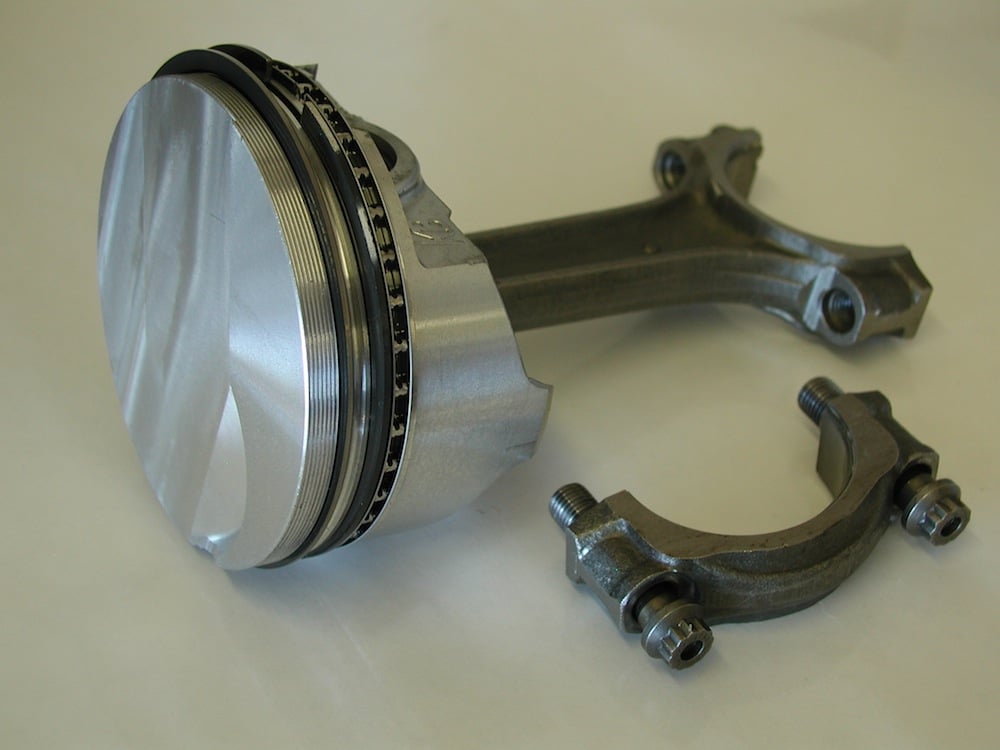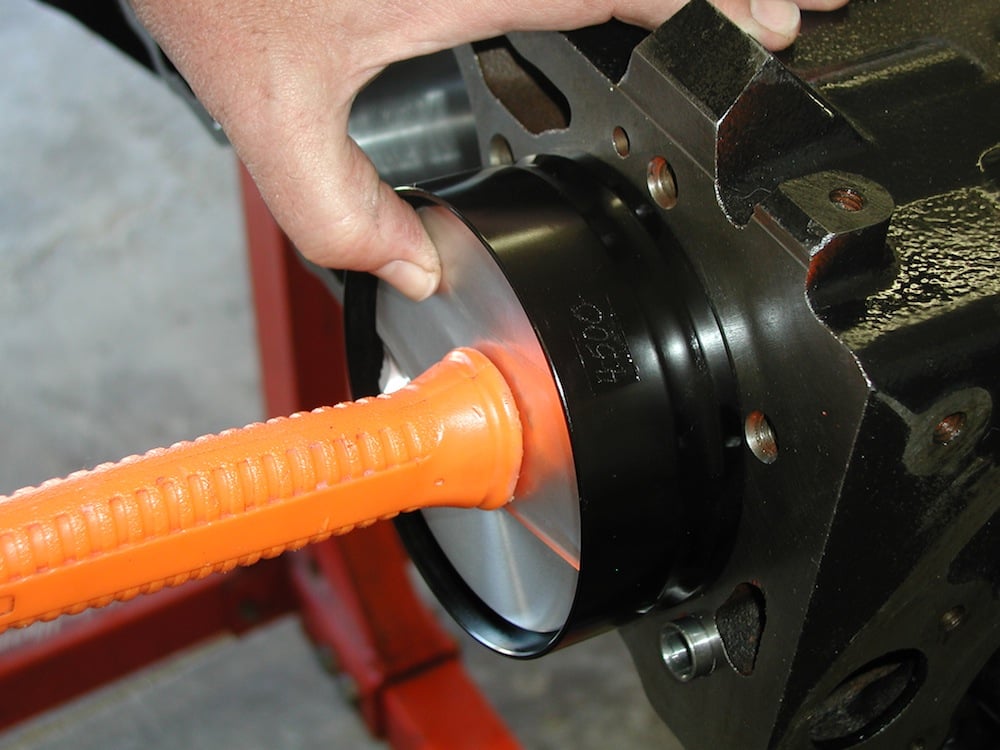One horsepower per cubic inch. Back in the 1950’s, that was the target. Those new-fangled overhead pushrod engines that revolutionized how passenger car engines were created only served to heat up the power per cube race. When the new Chevrolet Big Block engine was introduced in 1965, it lit the fuse for bigger power and renewed the focus on the power per cubic inch wars.

A man of many engines, Jim Shewbert has been building and racing engines, including anything from alcohol Funny Cars to Pebble Beach Concour-winning multimillion-dollar classics for 35 years. The challenge this time - building a streetable 540cid Mark V Big Block Chevy that could run on pump gas and make over 600hp.
Today, making big horsepower is still the ultimate goal; the one horsepower per one cube of displacement target but a mere dot in the rear view mirror of old aspirations. But complications to the engine building process have surfaced recently.
For many engine builders, the engines they create must make excellent power and still be compatible with today’s low quality pump gas (91 octane). In addition, they must be able to generate adequate vacuum and excellent daily-use drivability.
Just as today’s performance cars are compatible with formerly anti-performance style options such as air conditioning and power steering, most current engines don’t need 114-octane race fuel to avoid detonation while hitting the big power figures.
The fact is no engine builder wants to tell his clients that their freshly built engines require such coddling. Why should they when proper component selection will help them avoid such behavior?
A Little Big Block History
The Big Block Chevy engines of today come in a variety of shapes and styles. While the Mark IV, as introduced in 1965, went through some initial changes, it was not until 1991 that the Mark V engine came to be. Today the Mark V and its brother the Mark VI, which debuted in 1996, are great platforms for engine builders, offering great versatility and availability over the seemingly harder to find Mark IV engines.
The Mark V big block requires oil system bypass valves to make it compatible with an engine mounted oil filter system. Forget these bypass valves, and you can kiss your engine goodbye, as oil will not circulate properly through the engine. And don’t forget that threaded plug which fits in the oil pan rail as shown here.
Toby Allison reworked the entire length of the ports and valve bowls. The RHS Pro Action cylinder heads work great from the factory and run well without such modifications. Valve spring cups were used – another COMP Cams component.

Shewbert likes to run the Manley stainless steel valves for all his engines. These measure 2.250-intake intake and 1.880-inch exhaust.
Featuring a strong internal webbing, integrated oil pan gasket and one-piece round rear main seal to avoid oil pan drips, the Mark V was perfect for our needs. Paired with the hot performing RHS Pro Action aluminum cylinder heads, we were excited about the potential for what we believed would be an excellent combination for our street-based project.

The Mark V engine was outfitted with a set of ported Racing Head Service Pro Action cylinder heads further enhanced by Toby Allison. All of the valve train products, including lash caps, rocker arms, valve springs and camshaft were from COMP Cams. This camshaft was a mechanical roller unit featuring 306 degrees of intake duration (319-degree exhaust) and 0.680-inch lift.
The selection of the Mark V platform was the work of engine builder Jim Shewbert, who was hired to create the potent big cube engine for Ted Yurek’s ’70 Chevelle.
The car, while outfitted with a number of advanced suspension upgrades, was a true dual-purpose machine – both track and cruise time planned for the beautiful blue and SS-stripe clad Heavy Chevy.
While the engine was assembled in southern California, the Chevelle was expected to run on pump gas once dropped between the inner fenderwells of the Coeur d’Alene, Idaho-based Chevy. Owing to the huge amount of distance between L.A. and Idaho, it was imperative that the engine be powerful and reliable.
The Build Up
The building of the Mark V engine was not unique for the most part, a fairly straightforward assembly using Scat 6.385-inch 4340 H-beam connecting rods, Akerly & Childs extreme rings and 4.5-inch bore Keith Black Hypereutectic aluminum pistons. The pistons feature a 1/16-inch top moly piston ring and similar size cast iron second ring.
The RHS Pro Action heads use high quality guides. These were honed lightly to create an excellent valve to guide fitment. A light coating of white grease was applied to the threads of the COMP Cams rocker studs before they were torqued in place. The white grease ensures that they will come out if necessary without damaging the aluminum cylinder head. COMP Cams also makes the pushrod guide plates shown here as well.
This Fel-Pro head gasket features a special o-ring that ensures proper sealing. They work great with the RHS Pro Action heads. The RHS Pro Action aluminum cylinder heads were installed dry over the Fel-Pro gaskets, and ARP 12-point head bolts were used to apply the squeeze. For this application, Shewbert liked COMP Cams lash caps. White grease was used to fully lubricate the caps both on top and bottom. COMP Cams Pro Magnum Rockers were used with this high horsepower and torque engine. They work great on the street as well as the race track.
The Keith Black Hypereutectic pressure cast aluminum pistons were dressed with Akerly & Childs pistons rings and set at 10.25:1 compression. Gear Head’s 4.500-inch spring compressor was oiled up, and the Keith Black Pistons were tapped in place. The Scat 6.385-inch length connecting rods feature ARP bolts. Each rod cap nut was torque to 85 lb. ft. before installation. The crankshaft is an Eagle Forged unit with a 4.250-inch stroke.
540cid Engine Build Up:
-GM Mark V block, 4.5 bore, 9.800 deck
-Eagle forged crank 4.250in. stroke
-Scat 6.385-in. connecting rods
-KB 10.25:1 flat top pistons
-RHS Pro Action 360cc alum. heads, Mark IV style, 360cc runners
-Akerly & Childs rings
-COMP mech. roller cam (306AR-10)
-COMP timing chain
-COMP rocker studs, guide plates and lash caps
-COMP Pro Magnum Roller rockers
-COMP titanium retainers (731-16)
-COMP keepers
-COMP Valve springs (944-16)
-COMP Endure-X mech. roller lifters (866-16)
-COMP pushrods (7131-8 int, 7141-8 exh)
-Manley valves
-Fel-Pro gaskets
-Dart single-plane intake
-NGK spark plugs – 5/8-inch head
-Hooker headers 2/125-in. primaries
-ARP head bolts
-Competition Specialties front cover
-ATI front dampener
-MSD plug wires, billet distributor, 6AL ignition box
-Demon 850cfm carb
-Akerly & Childs bearings
-Milodon oil pan, (30951), pickup (18310) and pump
The pistons have a flat top, making for excellent flame propagation and when used with a 9.800-inch deck block, generate 10.25:1 compression. An Eagle forged steel crankshaft was used with a 4.250-inch stroke, making for 532ci total displacement (540ci for you government workers).
The cylinder heads were state of the art RHS Pro Action 360cc aluminum heads. The heads started plenty clean from the factory with excellent airflow and internal water-jacketing for consistent temperature control and were ported to the next level by Toby Allison.
Because of the high horsepower Jim wished to generate, he felt a Toby-porting job would help to eek out the engine’s top horsepower numbers.
In the valve train department, Shewbert clearly wanted a big camshaft to take advantage of the high flow cylinder heads and horsepower and torque handling attributes of the super strong Mark V short block.
To that end he selected a camshaft that featured large lift and duration numbers requiring a mechanical roller valve train which included COMP’s new Endure-X mechanical roller lifters.
In combination with the big camshaft, the COMP Cams tech line folks – (800) 999-0853 – helped him select appropriate valve springs, retainers, lifters, spring cups, lash caps and even the Pro Magnum roller rockers that were to be used with this combination.
Topping the engine was a Dart intake ported by Allison and a Demon reworked 850cfm carburetor. Big tube exhaust headers and low restriction Flowmaster tail pipes were slated for use, along with a five-speed manual transmission and high performance clutch.
The COMP Cams timing chain lower gear can be installed three different ways allowing for significant flexibility in engine timing. We put our gear on straight up. Don’t forget the camshaft button, which removes end play in the camshaft. As with any engine build up, it is important to know the exact timing of the engine’s camshaft. For our purposes, Shewbert set the camshaft at four degree advance. Shewbert loved the COMP Cams adjustable timing chain system. To get the four degrees advance he wanted, he simply used an Allen wrench to set the timing and locked it down with the camshaft timing gear bolts.

This camshaft installation tool from Gear Head Tools is handy for sliding in the camshaft without damaging the fragile camshaft bearings. Note that the camshaft was liberally lubricated with COMP Cams break-in lube prior to installation.
Shewbert selected the Dart single plane intake manifold for the 540ci engine for its great high horsepower capability. A staple with many engine builders today, this Demon 850cfm carburetor proved a worthy component for this dual-purpose application.
Gear Head Tools oil pump primer drops down the distributor hole and is turned with an electric drill to pre-prime the engine before firing. Shewbert prefers MSD ignition products for this engine, including the MSD billet distributor and MDS 6AL ignition box.
On To the Dyno
The folks at Westech Performance were hired to test the limits of our engine. Engine builder Jim Shewbert installed the camshaft with four degrees of advance, along with the Dart intake, Demon 850cfm carburetor and MSD ignition.
Using 91-octane fuel, Westech’s Steve Brule fired the engine and spent a considerable amount of time warming the engine, then resetting the valves and warming the engine again with some short low rpm pulls. After an hour of break-in time, they proceeded to make some test runs to see if we had done the proper homework.
The Mark V required a few jetting changes, and we adjusted the timing slightly during our four test pulls. In the end, our 540ci Mark V big block turned out an impressive 649.2 horsepower at 6200 rpm and 613 lb. ft. of torque at 4900 rpm. The most impressive part of the engine’s power and torque output was the consistent power delivery.
From 5700 through 6700 rpm, the engine maintained a minimum of 640 horsepower, less than 10 horsepower variance for over 1000rpm. In addition, the torque level reached 590lbs. ft. of torque starting at 4100 rpm and stayed above that level through 5700 rpm. This is usable street horsepower that would be more than up to any race challenge encountered by the classic Chevelle.
In the end, we were quite happy with the performance level of the 540ci engine. Making 650HP on pump gas is no small accomplishment and one that proved, street or race, Big Block Chevrolets have deservedly earned their reputation for relatable power. Even the often overlooked Mark V.
The oil filter fitting for the Mark V (left) differs from the standard Mark IV mount. They can’t be confused. The Milodon oil pump and pick-up are high volume units and are installed in this manner. Our initial installation of the Milodon pan was a learning experience. The pan rails interfered with the 4.250-inch stroked rods at the main rail - every one of them.










































